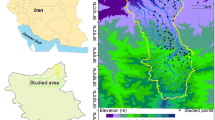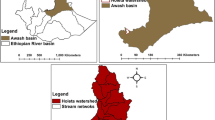Abstract
Reservoir sedimentation is a crucial challenge in planning and managing sustainable surface water resources in arid and semi-arid regions and must be assessed with accuracy. Both data-based models and conceptual models can be valuable tools for predicting reservoir sedimentation. In this study, we used an artificial neural network (ANN) approach and a modified Universal Soil Loss Equation coupled with multiple linear regression (MUSLE-MLR) model to predict yearly sedimentation in the Sidi Mohammed Ben Abdellah reservoir, located in a semi-arid region of Morocco. To construct the MUSLE-MLR model, we first calibrated and validated the MUSLE on 32 storms at four gauging stations upstream of the dam to estimate the sediment yield at these four gauging stations; we then developed the MLR model for combining sediment yield and reservoir sedimentation. The results of this model were then compared with the performance of the ANN model that was trained and validated over the periods 1975–2008 and 2009–2015, respectively. The comparison revealed that the calibrated MUSLE model is fairly useful to predict sediment yield at the watershed level. However, comparison of the two models during the validation process showed that the ANN (R2 0.91, Nash–Sutcliffe Efficiency [NSE] 0.820) is more accurate and more suitable than the MUSLE-MLR model (R2 0.819, NSE − 1.592) to predict reservoir sediment in the Sidi Mohammed Ben Abdellah reservoir. The findings of this study contribute to the armamentarium of potential tools that can be used to predict and manage reservoir sedimentation at the watershed and reservoir levels in a semi-arid context.






Similar content being viewed by others
References
Adeogun AG, Sule BF, Salami AW (2018) Cost effectiveness of sediment management strategies for mitigation of sedimentation at Jebba Hydropower reservoir. Niger J King Saud Univ Sci 30:141–149
Afan HA, El-shafie A, Mohtar WHMW, Yaseen ZM (2016) Past, present and prospect of an Artificial Intelligence (AI) based model for sediment transport prediction. J Hydrol 541:902–913
Alahiane N, Elmouden A, Aitlhaj A, Boutaleb S (2016) Small dam reservoir siltation in the Atlas Mountains of Central Morocco: analysis of factors impacting sediment yield. Environ Earth Sci 75:1035
Alewell C, Borrelli P, Meusburger K, Panagos P (2019) Using the USLE: Chances, challenges and limitations of soil erosion modelling. Int Soil Water Conserv Res 7:203–225. https://doi.org/10.1016/j.iswcr.2019.05.004
Al-Saidi M, Birnbaum D, Buriti R, Diek E, Hasselbring C, Jimenez A, Woinowski D (2016) Water resources vulnerability assessment of MENA countries considering energy and virtual water interactions. Proced Eng 145:900–907. https://doi.org/10.1016/j.proeng.2016.04.117
Appel KJ (2006) Characterisation of badlands and modelling of soil erosion in the Isábena watershed, NE Spain. MSc thesis. University of Potsdam, Potsdam. https://brandenburg.geoecology.uni-potsdam.de/projekte/sesam/download/abstracts/MScThesis_Katharina_Appel.pdf
Aykut NO, Akpınar B, Aydın Ö (2013) Hydrographic data modeling methods for determining precise seafloor topography. Comput Geosci 17:661–669. https://doi.org/10.1007/s10596-013-9347-1
Bachiller AR, Rodríguez JLG, Sánchez JCR, Gómez DL (2019) Specific sediment yield model for reservoirs with medium-sized basins in Spain: an empirical and statistical approach. Sci Total Environ 681:82–101. https://doi.org/10.1016/j.scitotenv.2019.05.029
Belmar O, Velasco J, Martinez-Capel F (2011) Hydrological classification of natural flow regimes to support environmental flow assessments in intensively regulated Mediterranean rivers, Segura River Basin (Spain). Environ Manag 47:992–1004. https://doi.org/10.1007/s00267-011-9661-0
Bengora D, Khiari L, Gallichand J, Dechemi N, Gumiere SJ (2018) Optimizing the dataset size of a topo-bathymetric survey for Hammam Debagh Dam. Algeria Int J Sediment Res 33:518–524
Boardman J, Shepheard ML, Walker E, Foster IDL (2009) Soil erosion and risk-assessment for on- and off-farm impacts: A test case using the Midhurst area, West Sussex, UK. J Environ Manag 9(8):2578–2588. https://doi.org/10.1016/j.jenvman.2009.01.018
Bonumá NB, Rossi CG, Arnold JG, Reichert JM, Minella JP, Allen PM, Volk M (2014) Simulating landscape sediment transport capacity by using a modified SWAT model. J Environ Qual 43:55–66
Bouguerra H, Bouanani A, Khanchoul K, Derdous O, Tachi SE (2017) Mapping erosion prone areas in the Bouhamdane watershed (Algeria) using the Revised Universal Soil Loss Equation through GIS. J Water Land Dev 32:13–23
Bouguerra S, Jebari S, Tarhouni J (2019) An analysis of sediment production and control in Rmel river basin using InVEST sediment retention model. J New Sci 66:4170–4181
Brune GM (1953) Trap efficiency of reservoirs. Eos Trans Am Geophys Union 34:407–418
Cambazoǧlu MK, Göǧüş M (2004) Sediment yields of basins in the Western Black Sea region of Turkey. Turk J Eng Environ Sci 28:355–367
Clark ML (2015) Using GIS and the RUSLE model to create an index of potential soil erosion at the large basin scale and discussing the implications for water planning and land management in Morocco. https://hdl.handle.net/2152/35476
Droogers P, Immerzeel WW, Terink W, Hoogeveen J, Bierkens MFP, Van Beek LPH, Debele B (2012) Water resources trends in Middle East and North Africa towards 2050. Hydrol Earth Syst Sci 16:3101–3114
Garg V, Jothiprakash V (2013) Evaluation of reservoir sedimentation using data driven techniques. Appl Soft Comput J 13:3567–3581. https://doi.org/10.1016/j.asoc.2013.04.019
Gholami V, Booij MJ, Tehrani EN, Hadian MA (2018) Spatial soil erosion estimation using an artificial neural network (ANN) and field plot data. CATENA 163:210–218
Girolamo AM, De Calabrese A, Lo Porto A, Oueslati O, Pappagallo G, Santese G (2011) Hydrologic regime characterization for a semi-arid watershed [Beschreibung des hydrologischen Regimes eines semiariden Einzugsgebiets]. Die Bodenkultur 62(1–4). https://diebodenkultur.boku.ac.at/volltexte/band-62/heft-1-4/degirolamo.pdf
Goh ATC (1994) Seismic liquefaction potential assessed by neural networks. J Geotech Eng 120:1467–1480
Hassan R, Al-Ansari N, Ali AA, Ali SS, Knutsson S (2017) Bathymetry and siltation rate for Dokan Reservoir. Iraq Lakes Reserv Res Manag 22:179–189
Haykin S (1999) Neural networks, a comprehensive foundation. Prentice-Hall, Saddle River
Jothiprakash V, Garg V (2009) Reservoir sedimentation estimation using artificial neural network. J Hydrol Eng 14:1035–1040
Ketema A, Dwarakish GS (2019) Water erosion assessment methods: a review. ISH J Hydraul Eng. https://doi.org/10.1080/09715010.2019.1567398
Khan MYA, Tian F, Hasan F, Chakrapani GJ (2019) Artificial neural network simulation for prediction of suspended sediment concentration in the River Ramganga, Ganges Basin. India Int J Sediment Res 34:95–107. https://doi.org/10.1016/j.ijsrc.2018.09.001
Knott JM, Sholar CJ, Matthes WJ (1992) Quality assurance guidelines for the analysis of sediment concentration by US Geological Survey sediment laboratories. US Department of the Interior, US Geological Survey, Washington DC
Kondolf GM, Gao Y, Annandale GW, Morris GL, Jiang E, Zhang J, Cao Y, Carling P, Fu K, Guo Q, Hotchkiss R, Peteuil C, Sumi T, Wang H-W, Wang Z, Wei Z, Wu B, Wu C, Yang CT (2014) Sustainable sediment management in reservoirs and regulated rivers: experiences from five continents. Earth’s Futur 2:256–280. https://doi.org/10.1002/2013ef000184
Liu QJ, Zhang HY, Gao KT, Xu B, Wu JZ, Fang NF (2019) Catena time-frequency analysis and simulation of the watershed suspended sediment concentration based on the Hilbert-Huang transform (HHT) and arti fi cial neural network (ANN) methods : a case study in the Loess Plateau of China. CATENA 179:107–118. https://doi.org/10.1016/j.catena.2019.03.042
Maina CW, Sang JK, Mutua BM, Raude JM (2018) Bathymetric survey of Lake Naivasha and its satellite Lake Oloiden in Kenya; using acoustic profiling system. Lakes Reserv Res Manag 23:324–332
McCulloch WS, Pitts W (1943) A logical calculus of the ideas immanent in nervous activity. Bull Math Biophys 5:115–133
Merheb M, Moussa R, Abdallah C, Colin F, Perrin C, Baghdadi N (2016) Hydrological response characteristics of Mediterranean catchments at different time scales: a meta-analysis. Hydrol Sci J 61:2520–2539. https://doi.org/10.1080/02626667.2016.1140174
Mitasova H, Hofierka J, Zlocha M, Iverson LR (1996) Modelling topographic potential for erosion and deposition using GIS. Int J Geogr Inf Syst 10:629–641
Moriasi DN, Arnold JG, Van Liew MW, Bingner RL, Harmel RD, Veith TL (2007) Model evaluation guidelines for systematic quantification of accuracy in watershed simulations. Trans ASABE 50:885–900. https://doi.org/10.13031/2013.23153
Mulu A, Dwarakish GS (2015) Different approach for using trap efficiency for estimation of reservoir sedimentation. An overview. Aquat Proced 4:847–852. https://doi.org/10.1016/j.aqpro.2015.02.106
Niu B, Qu J, Zhang XJ, Liu B, Tan L, An Z (2019) Quantifying provenance of reservoir sediment using multiple composite fingerprints in an arid region experiencing both wind and water erosion. Geomorphology 332:112–121. https://doi.org/10.1016/j.geomorph.2019.02.011
Noori N, Kalin L (2016) Coupling SWAT and ANN models for enhanced daily streamflow prediction. J Hydrol 533:141–151
Palmieri A, Shah F, Dinar A (2001) Economics of reservoir sedimentation and sustainable management of dams. J Environ Manag 61:149–163
Pradhan P, Tingsanchali T, Shrestha S (2020) Evaluation of soil and water assessment tool and artificial neural network models for hydrologic simulation in different climatic regions of Asia. Sci Total Environ 701:134308
Qiu LJ, Zheng FL, Yin RS (2012) SWAT-based runoff and sediment simulation in a small watershed, the loessial hilly-gullied region of China: capabilities and challenges. Int J Sediment Res 27:226–234. https://doi.org/10.1016/S1001-6279(12)60030-4
Renard KG, Foster GR, Weesies GA, Porter JP (1991) RUSLE: Revised universal soil loss equation. J Soil Water Conserv 46:30–33
Rumelhart DE, Hinton GE, Williams RJ (1985) Learning internal representations by error propagation. In: Parallel distributed processing: explorations in the microstructure of cognition, volume 1: Foundations. MIT Press, Cambridge, 318–362
Sadeghi SHR, Mahdavi M (2004) Applicability of SEDIMOT II model in flood and sediment yield estimation. J Agric Sci Technol 6:147–154
Sadeghi SHR, Gholami L, Khaledi Darvishan A, Saeidi P (2014) A review of the application of the MUSLE model worldwide. Hydrol Sci J 59:365–375
Schütte R, Plaas E, Gómez JA, Guzmán G (2020) Profitability of erosion control with cover crops in European vineyards under consideration of environmental costs. Environ Dev 35:100521. https://doi.org/10.1016/j.envdev.2020.100521
Sepuru TK, Dube T (2018) An appraisal on the progress of remote sensing applications in soil erosion mapping and monitoring. Remote Sens Appl Soc Environ 9:1–9. https://doi.org/10.1016/j.rsase.2017.10.005
Singh A, Imtiyaz M, Isaac RK, Denis DM (2012) Comparison of soil and water assessment tool (SWAT) and multilayer perceptron (MLP) artificial neural network for predicting sediment yield in the Nagwa agricultural watershed in Jharkhand. India Agric Water Manag 104:113–120. https://doi.org/10.1016/j.agwat.2011.12.005
Tadesse A, Dai W (2019) Prediction of sedimentation in reservoirs by combining catchment based model and stream based model with limited data. Int J Sediment Res 34:27–37. https://doi.org/10.1016/j.ijsrc.2018.08.001
Tan G, Chen P, Deng J, Xu Q, Tang R, Feng Z, Yi R (2019) Review and improvement of conventional models for reservoir sediment trapping efficiency. Heliyon 5:e02458. https://doi.org/10.1016/j.heliyon.2019.e02458
Tu JV (1996) Advantages and disadvantages of using artificial neural networks versus logistic regression for predicting medical outcomes. J Clin Epidemiol 49:1225–1231. https://doi.org/10.1016/S0895-4356(96)00002-9
Van der Knijff JMF, Jones RJA, Montanarella L (1999) Soil erosion risk assessment in Italy. Citeseer, New Jersey
White R (2001) Evacuation of sediments from reservoirs. Thomas Telford Ltd., London
Williams JR, Berndt HD (1976) Sediment yield prediction based on watershed hydrology. American Society of Agricultural Engineering, St. Joseph
Wischmeier WH, Smith DD (1965) Predicting rainfall-erosion losses from cropland east of the Rocky Mountains: guide for selection of practices for soil and water conservation. US Department of Agriculture, Washington
Zhou W, Wu B (2008) Assessment of soil erosion and sediment delivery ratio using remote sensing and GIS: a case study of upstream Chaobaihe River catchment, north China. Int J Sediment Res 23(2):167–173. https://doi.org/10.1016/S1001-6279(08)60016-5
Acknowledgements
The authors would like to thank the River Basin Agency of Bouregreg and Chaouia (RBABC) for their support and cooperation in providing all of the data required for this study. The authors also thank three anonymous reviewers for their constructive comments and suggestions.
Funding
The authors have not received any funding for this research
Author information
Authors and Affiliations
Corresponding author
Ethics declarations
Conflict of interest
All authors report that there are no conflicts of interest.
Additional information
Communicated by Sudip Chakraborty, Chief Editor.
Rights and permissions
About this article
Cite this article
EL Bilali, A., Taleb, A., EL Idrissi, B. et al. Comparison of a data-based model and a soil erosion model coupled with multiple linear regression for the prediction of reservoir sedimentation in a semi-arid environment. Euro-Mediterr J Environ Integr 5, 64 (2020). https://doi.org/10.1007/s41207-020-00205-8
Received:
Accepted:
Published:
DOI: https://doi.org/10.1007/s41207-020-00205-8




